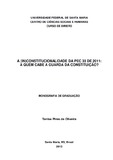| dc.contributor.advisor | Nedel, Nathalie Kuczura | |
| dc.creator | Oliveira, Tanise Pires de | |
| dc.date.accessioned | 2017-08-21T16:48:29Z | |
| dc.date.available | 2017-08-21T16:48:29Z | |
| dc.date.issued | 2013-12-12 | |
| dc.date.submitted | 2013 | |
| dc.identifier.uri | http://repositorio.ufsm.br/handle/1/11429 | |
| dc.description | Trabalho de conclusão de curso (graduação) - Universidade Federal de Santa Maria, Centro de Ciências Sociais e Humanas, Curso de Direito, RS, 2013. | por |
| dc.description.abstract | The idea of supremacy of the Constitution brings inculcated the necessity of
performing a law control, reason why two major systems have been created, the one
performed by diffuse/incidental pathway, originating in the United States, and the
concentrated system, originated in Austria. The Austrian system, developed by the
jurist Hans Kelsen in the early twentieth century, assigned the guard of the
Constitution to a Constitutional Court parallel to the Judiciary Power, with exclusive
jurisdiction to annul the laws incompatible with the Constitution. After World War II,
this system has spread Europe apart, parallel to the phenomenon of
constitutionalism. However, it was assigned to the Judiciary the competence to
perform the abstract law control, as well as new instruments of interpretation were
created, such as, for example, a conforming interpretation. In Brazil, the concentrated
system was adopted by the Constitutional Amendment No. 16 of 1965, which created
the institute of Representation of Inconstitutionality, under the exclusive jurisdiction of
the General Attorney of the Republic. In the Federal Constitution of 1988, this
mechanism has been enhanced, transforming itself in the Unconstitutionaly Direct
Action, whose list of legitimated was expanded. Beside this, new law control tools
were created, such as the Declaratory Action of Constitutionality, Direct Action by
Omission and the accusation of breach of fundamental precept. Therefore, the
actions that pugnavam the constitutionality of laws greatly increased after the advent
of the new Constitution, which altered the institutional role of the Supreme Court. In
this context, arises the Proposed Constitutional Amendment No. 33 of 2011 with the
main goal of restoring the balance between the Powers. Among the proposed
changes, the PEC 33/2011 aims to remove from the Praetorium Exalted the
exclusivity of law control, subjecting the decisions of merit given by the Supreme
Court that consider the Constitutional Amendments uncontitucionals to the National
Congress and, secondarily, to the population. Thus, this study aims to analyze the
constitutionality of this proposal in the actual juncture of law control established by
the legal system. | eng |
| dc.language | por | por |
| dc.publisher | Universidade Federal de Santa Maria | por |
| dc.rights | Acesso Aberto | por |
| dc.subject | Proposta de emenda constitucional nº 33 de 2011 | por |
| dc.subject | Controle de constitucionalidade concentrado | por |
| dc.subject | Proposed constitutional amendment Nº. 33/2011 | eng |
| dc.subject | Concentrated constitucionality control | eng |
| dc.subject | Guard of the constitution | eng |
| dc.subject | Guarda da constituição | por |
| dc.title | A (in)constitucionalidade da PEC 33 de 2011: a quem cabe a guarda da constituição? | por |
| dc.title.alternative | The (un)constitutionality of the pec 33, 2011: to whom belongs the guard of the constitution? | eng |
| dc.type | Trabalho de Conclusão de Curso de Graduação | por |
| dc.degree.local | Santa Maria, RS, Brasil | por |
| dc.degree.graduation | Direito | por |
| dc.description.resumo | A ideia de supremacia da Constituição traz incutida a necessidade de realização de
controle de leis, razão pela qual dois grandes sistemas foram criados, o efetuado
pela via difusa/incidental, com origem nos Estados Unidos, e o sistema concentrado,
de raiz austríaca. O sistema austríaco, elaborado pelo jurista Hans Kelsen no início
do século XX, atribuiu a guarda da Constituição a uma Corte Constitucional paralela
ao Poder Judiciário, com competência exclusiva de anular as leis incompatíveis com
a Constituição. Ápós a Segunda Guerra Mundial, esse sistema disseminou-se
Europa afora, concomitantemente ao fenômeno do constitucionalismo. Todavia,
atribuiu-se ao Poder Judiciário a competência para realizar o controle abstrato de
leis, bem como criaram-se novos instrumentos de interpretação, como por exemplo,
a interpretação conforme. No Brasil, o sistema concentrado foi adotado com a
Emenda Constitucional nº 16 de 1965, que criou o instituto da Representação de
Inconstitucionalidade, de competência exclusiva do Procurador-Geral da República.
Na Constituição de 1988, esse mecanismo foi aprimorado, transformando-se na
Ação Direta de Inconstitucionalidade, cujo rol de legitimados foi ampliado. Ao lado
disso, foram criados novos instrumentos de controle de leis, como a Ação
Declaratória de Constitucionalidade, a Ação Direta por Omissão e a Arguição de
Descumprimento de Preceito Fundamental. Diante disso, as ações que pugnavam
pelo controle de constitucionalidade de leis aumentaram sobremaneira após o
advento da nova Carta, o que alterou o papel institucional do Supremo Tribunal
Federal. Nesse contexto, surge a PEC 33/2011, com o objetivo principal de restaurar
o equilibrio entre os Poderes. Dentre as aleterações propostas, a PEC 33/2011 visa
retirar do Pretório Excelso a exclusividade do controle de leis, submetendo as
decisões de mérito proferidas pelo Supremo Tribunal que entendam pela
inconstitucionalidade material de Emendas Constitucionais à apreciação do
Congresso Nacional e, de forma subsidiária, a população. Assim, o presente
trabalho tem como objetivo analisar a constitucionalidade dessa proposta na atual
conjuntura de controle de leis estabelecida no ordenamento jurídico. | por |
| dc.publisher.country | Brasil | por |
| dc.publisher.initials | UFSM | por |
| dc.subject.cnpq | CNPQ::CIENCIAS SOCIAIS APLICADAS::DIREITO | por |
| dc.publisher.unidade | Centro de Ciências Sociais e Humanas | por |


